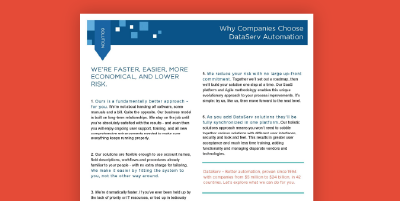Successful Shared Services Automation for Accounts Payable
Keys to Success
- Software as a Service
- Automated workflow
- Best practices
- Comprehensive reporting
- Effective change management
Whether a Fortune 500 or a Regional Distributor, many organizations have organized their business around physical assets: raw materials, customers or suppliers. As such, business processes and human capital have also clustered around these physical assets. Over a period of years these business processes evolve (or devolve) based upon the demands of the local team, regulations, expansion, contraction, recessions, leadership and any number of other variables.
At the same time, business stakeholders (whether they are investors, directors, employees, or the general public) are demanding greater accountability and visibility. Key to providing increased levels of visibility is to take greater control of your business process, no matter where it lives.
So how do organizations accomplish this?
One area where businesses are making tremendous strides is inside their financial operations. These operations tend to be heavily paper based and labor intensive, but have a significant impact on cash flow and earnings. (A study by the Aberdeen Group in 2011 found that 77% of all invoices received by a business are paper based. That this is the case, even after all the advances made in EDI, supplier portals, electronic invoicing and all the rest, speaks to the need for businesses to have workflow processes that can handle any form or document.) Yet, it is also true that this area of the business receives little new investment and funding. Many global businesses have addressed this paradox through the deployment of shared services.
Effectively conceived and implemented shared services for financial operations include:
- Software as a Service (SaaS) – Extending the investment and making the solution available across the organization, easily accessed by any web-enabled device.
- Automated workflow – Translate “tribal knowledge” into a consistent, naturally reinforced, trainable and auditable system that matches your unique business process while saving you time and money.
- Best practices – Successful SaaS providers incorporate “Best Practices” into their systems so clients are not required to pay outside consultants for specialized process knowledge.
- Comprehensive reporting – To control and report on the process, its outcomes and the value it creates. Making information in the process visible is one of the greatest benefits.
- Effective change management – Helping people to embrace the new way of doing business. It is not about installing software, but helping your employees and vendors successfully transition and embrace the change quickly and with minimum disruption.
We have extensive experience working with clients to solve these issues.
For example, a large global manufacturer has been a client for more than ten years. This company was built through acquisitions over many years, which meant it had a wide variety of business processes and redundant technologies to support. It was looking to lower transactional processing costs for both independent divisions and corporate departments. With a large engineering presence in Manila, a country with strong business skills, and a college-educated, low-cost English-speaking workforce, they decided to build a shared services center and relocate typical back office functions from across the globe to this location.
The initial phase of this strategy saw the client move a significant portion of its work to Manila. Much of this early work focused on the technology necessary to simply move documents/images. This approach (dubbed “lift and shift”) provided immediate cost savings due to “labor arbitrage” but did not address the independent division’s desires for increased automation, expanded language capabilities and more flexible time-zone coverage.
The next phase of this deployment sought to balance cost efficiencies with the unique needs of their many divisions. With hundreds of business units of many different sizes, from $100 million to several billion in revenue, the needs of each business varied greatly. The flexibility of a SaaS solution has proven to be a key contributor to this next phase of improvement. Through SaaS business process automation technology from DataServ, the company is creating flexible, scalable service offerings that can:
- Span the globe
- Adapt to local or regional regulations
- Address unique business processes, from engineering services to heavy manufacturing
- Provide improved efficiencies and controls through software-embedded best practices
- Deliver solutions rapidly in collaboration with the businesses (i.e. Tailoring)
The business is also seeking to establish more consistent global standards for these operations, particularly with regard to:
- Pricing
- Interoperability
- Consistent technology
- Effective business processes
- Greater internal controls and audit visibility
In addition to these important benefits, DataServ has brought new thinking to this client, solving problems and expanding the benefits throughout the company as a collaborative partner. By demonstrating and explaining the solution repeatedly across all geographies and business units, DataServ is helping to create a business process improvement culture. We work as an extension of the Controller’s office and on behalf of Shared Services to drive more rapid change throughout the organization. This will enable the company to continue evolving and improving while lowering costs and, most importantly, focusing on opportunities within their business and markets.
Learn more at www.DataServ.com
Let’s Start a Conversation
Regardless of where you are at in your AP automation journey, DataServ will meet you there and help you evolve.




